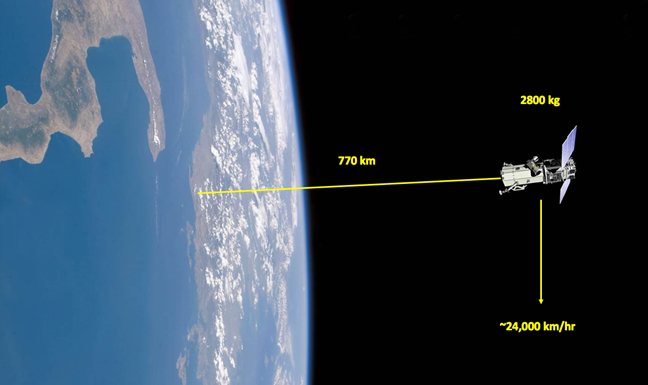
Credit: Digital Globe
WASHINGTON: After a vigorous interagency debate, new rules have been drafted for licensing commercial remote sensing satellites proposed by the Commerce Department would reduce DoD control over decision-making. The proposed rules, designed to speed the licensing process, would overturn the current process of case-by-case review that require DoD and State Department input in favor of a two-tier license system, based primarily on the potential risk to national security.
“One of the primary benefits to industry from the proposed rule is in curtailing the interagency application review process,” the Commerce Department explains in its proposal. “Under the existing regulations, every applicant receives the same interagency review, with the potential for specialized license conditions of which the applicant had no prior notice. This interagency review process has sometimes resulted in prolonged delays to license issuance, and has imposed license conditions that the applicant could not have anticipated when developing their system.”
The Commerce proposal estimates that 40 percent of license applications would be considered “low risk” requiring little review, with the rules guaranteeing a 60-day turn-around for a license decision.
One official involved in the discussions says reducing DoD’s grip on the license review process to allow easing regulatory burdens was hard fought in the interagency process. As a result, the rule changes do not go as far as many in industry might have hoped to actually ease commercial sales and exports of remote sensing data. This is particularly true for imaging of other spacecraft on orbit, and for Synthetic Aperture Radar (SAR) satellites. The rules regarding sharing data from both of these types of operations have remained more or less the same.
The new rules are contained in a notice of public rule-making (NPRM) from the National Oceanic and Atmospheric Administration (NOAA, currently in charge of remote sensing regulations for Commerce) issued yesterday. The review of remote sensing rules was mandated by the White House in Space Policy Directive-2 (SPD-2) in an effort to cut red tape and promote commercial innovation. To that end the new rules will operate with a presumption of approval, in contrast to State Department military export licenses which presume rejection. In essence, the new rules would create a form of ‘generic’ license for most remote sensing activities, while applying a more robust process for those found to be of potential national security concern.
Even for applications considered to be “high risk,” the new rules would apply a set of standardized criteria for most. Commerce expects only about 20 percent of the license requests to present enough risk to require individual license review under the new rules, because those applications would involve “novel” activities that could create risks to other operators and/or national security. The NPRM does not define “novel” — except to say that these would be “such that the standard license conditions do not adequately address their risks.” (That said, activities that fall between the cracks in the US space regulatory regime include mega-constellations, very small satellites, and on-orbit servicing vehicles.)
While the majority of the proposed new rules are aimed at streamlining licensing for commercial firms, there is at least one significant new requirement for satellite systems deemed high risk designed to deal with cybersecurity/data protection. Cybersecurity for highly integrated satellite constellations involving on-orbit data processing is a key DoD concern. The NPRM explains:
“[E]xisting regulations do not specify data protection criteria, instead requiring the licensee to develop, submit, obtain approval of, and then follow a data protection plan. By contrast, the proposed rule specifies data protection criteria to increase clarity: The standard license conditions in the proposed rule require high-risk licensees to choose a NIST-approved and validated encryption method with a key length of at least 256 bits for encrypting TT&C [telemetry, tracking and command] and all data transmissions, and to implement additional measures, consistent with industry best practice, to prevent unauthorized system access.”
The NPRM keeps in place current restrictions on satellite imaging of other spacecraft unless written permission is obtained, including limiting resolution to above 0.5 meters. Providing imagery of objects not included in the US military’s space object catalog and published in space-track.org continues to be verboten. It further maintains strict limits on commercial use of synthetic aperture radar (SAR) data including limiting resolution to 0.25 meters, and banning any transmission of SAR data to receivers outside the US.
Further, companies proposing high-risk applications can be required to make technical modifications even after a license has been approved for national security reasons (as determined by DoD). If that happens, however, the US government will pay the tab.
The Satellite Industry Association (SIA) welcomed the moves toward streamlining. In an email response to my questions, SIA said: “SIA supports the streamlining of the remote sensing licensing process and the recognition that not all mission sets should require interagency review.” Noting recent NOAA efforts to shorten waiting times for licensing decisions, SIA added that the industry group “hopes that with this NPRM, licensing will be further streamlined for both typical satellite applications as well as for novel applications of remote sensing. Expedient and transparent licensing is necessary to ensure continued US leadership in remote sensing.”
The new NPRM is open for comment by industry and other interested parties until July 15, 2019.
Space Force EW unit working to integrate new weapon systems, intel personnel
The Space Force’s Delta 3 is responsible for organizing, training and equipping Guardians for electronic warfare missions involving satellite communications, as well as sustaining related offensive and defensive EW systems.


























